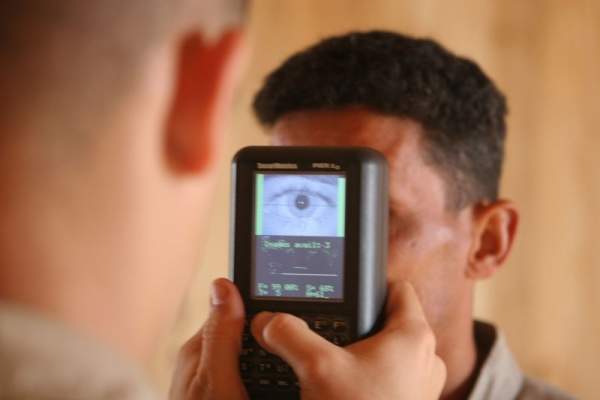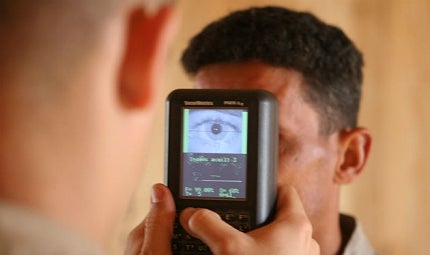

"Sometime between ’06 and ’07 in Iraq, that’s when biometrics became a game changer," explains Colonel Natalie Jacaruso in the latest annual report from the US Biometrics Identity Management Agency (BIMA).
A veteran of that conflict, who played a key part in establishing biometrics during Operation Iraqi Freedom, she describes biometrics as having gone from a handful of individual devices and novel technologies, to a genuine weapons system that has changed the face of conflict. It has, she says, "allowed us to develop identity dominance" – and the rugged, soldier-portable, tactical devices capable of being deployed on the battlefield have become firmly established as essential in maintaining it.
Invaluable tactical tools
"Having a handheld biometric tool is invaluable for today’s soldier," says Charles Strasburger, founder, chairman and CEO of Raptor Identification Systems. "Soldiers today face a new challenge on the battlefield. The enemy is hidden within the civilian population, so biometric screening is now mission critical. With a robust enough handheld biometric tool the identification process becomes exponentially easier."
He explains that for tactical biometric devices to be effective in-field, they need to be easy to use, capable of interfacing with anybody’s back-end database, and most importantly, affordable. "We’ve seen time and again devices sitting in warehouses because it takes too long to train the user, or we see soldiers using suboptimal equipment because it’s the only equipment that works with the database of record." There are also, he says, some devices in the marketplace today that are based on technology platforms that are perhaps five or more years out of date.
In September, his company entered into a strategic partnership with leading 3D facial recognition technology firm Animetrics, to unite Raptor’s ruggedized, open-platform Android 4.0-based mobile devices, with their high-precision, next-generation biometric software.
The upshot will see powerful facial recognition tools able to run as localised applications, reducing soldiers’ dependency on the technology at their home base, and allowing instant access to watchlists – and faster possible suspect matching.
According to Animetrics’ CEO, Paul Schuepp, it represents a classic bringing together of hardware advances with enhanced software solutions to provide vital information, swiftly, to the warrior on the ground. "The key is to have an entire solution with all the capabilities to resolve identities and that’s what the Raptor and Animetrics partnership is designed to do."
Fusing the biometrics
With the call having just closed for the US Special Operations Command’s latest round of tests to be held at Fort Bragg in December, the focus rests squarely on next-generation, handheld, multimodal biometric devices, and their accuracy, ergonomics and usability.
As Schuepp explains, ‘fusing the biometrics’ by bringing multiple technologies to bear increases the probability of obtaining a successful identification, and while facial recognition is typically the most useful in the field for checking a potential suspect, other biometrics have their value in tactical systems, depending on operational circumstances.
"Fingerprints, palmprints, iris – not retina – are all very good for a positive ID if you can get them," he says.
"Face works for covert use; the others do not. All biometrics can work very well for checkpoint safety, doing a one-to-one verification to authenticate people, not search [for them through a watchlist or database] and then safely let them through the checkpoint."
More partnerships?
With multiple systems competing for defence contracts, some observers have suggested that the future may see more alliances – such as the one between Animetrics and Raptor – particularly since as BIMA Director, Dr. Thomas Killion, notes, austerity looms "at a time when improvements in biometrics technologies and capabilities are accelerating."
There have already been some moves in this direction, such as the partnership formed by GTSI and Cross Match Technologies to fulfil the $159m Biometric Automated Toolset-Army contract that GTSI was awarded in 2011, and Strasburg thinks there may be more to come. "These partnerships allow software makers to focus on doing what they do best – software – and leverage flexible, adaptable and open hardware platforms without having to invest in them."
As a result, hardware providers would be able to serve and aggregate multiple markets, and that inevitably leads to higher volumes and lower costs per device. It seems the idea is gaining momentum. "In the first 30 days after the 2012 Biometrics Consortium Conference in Tampa, Raptor ID has entered into discussions, and in many cases already formalized strategic partnerships, with 37 software developers and major integrators," Strasburg says.
ID-at-a-distance
During the last decade or so, military biometrics have undergone a steady evolution, from a suite of security-enabling technologies to a robust and enduring war-fighting capability – and that transformation seems set to continue as the ‘identity dominance’ doctrine gains traction. It all adds up to some interesting challenges for the up-coming generations of in-field handheld devices.
Better identity resolution at a distance is one that both Animetrics and Raptor see as high on the list, as Strasburger explains. "Facial capture is one technology that has potential, something Animetrics is doing well with, and [is] focused on deploying. Iris capture has gained an incredible amount of support because of its accuracy, but fielding it has been a challenge. Historically, capturing an iris image is a very intrusive process that only works from a very specific range. Raptor products benefit from being ‘point, shoot and capture’ so we’re really paving the way for effective and practical iris capture."
In five or ten years time, he suggests, there is a real possibility that the technology will allow soldiers to be able to hold up a palm sized device, and know the identities of everyone around them within seconds – at the touch of a button.
Even sooner than that, Schuepp sees mobile devices enabling direct access to large databases of GPS and geographical information, and adding augmented reality to provide automatic overlays to highlight relevant alerts and other locally important data and details. "The future calls for a more ‘information age’ [approach] and more remote access usage," he says. "Tying in the field use and regional data to the Pentagon or the BIMA databases is critical to the fast identity tracking and resolution of personnel and the enemy."
Strasburger shares a similar vision. "Historically, biometric screening was the role of maybe one person in the platoon at best. There are still significant challenges in the form of policy issues for the use of biometrics in the field, but the day is fast approaching where affordable pocket-sized biometric tools will be carried by every soldier, casting each as an identification ‘sensor’ in a widespread, highly effective identification net."
Related content
Battlefield smartphones receive a ringing endorsement
Technological advancements have thrust smartphones from the hands of teenagers to the heart of the battlefield.
GPS: new technology solves an old problem
No other military technology has been so eagerly embraced in more applications, or by so many diverse markets, than the global positioning system (GPS).



